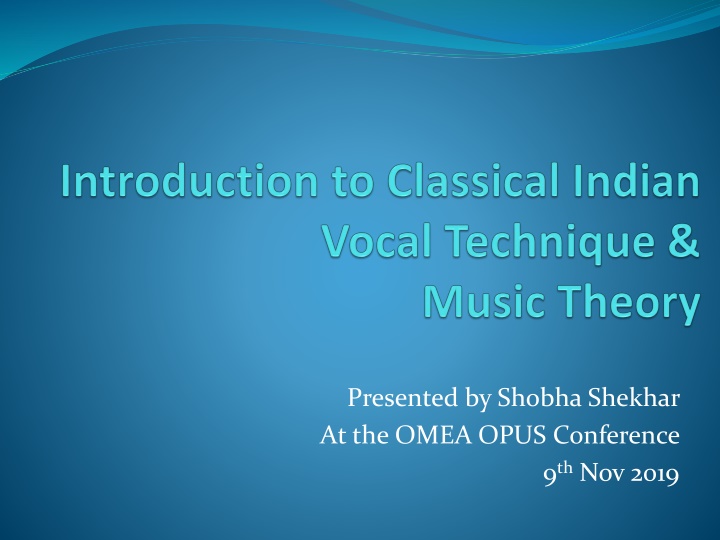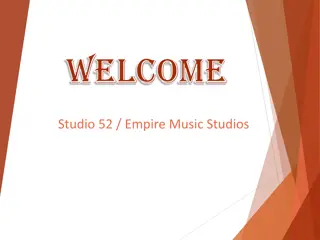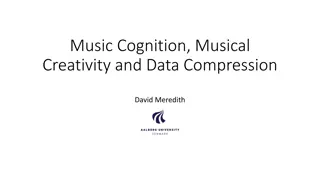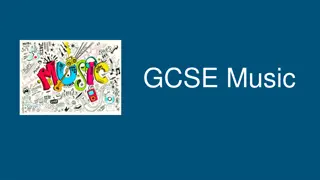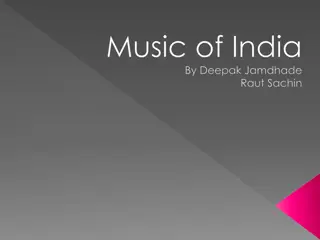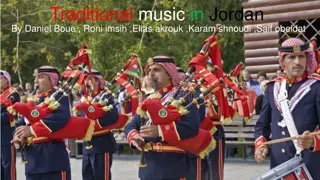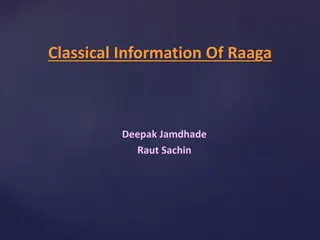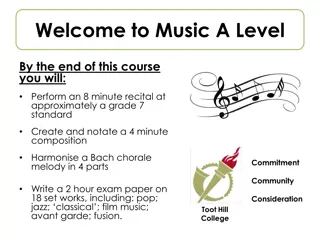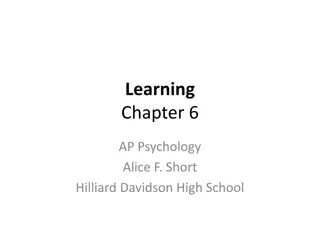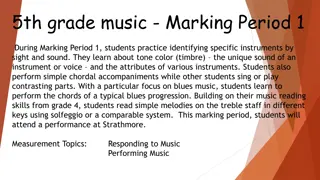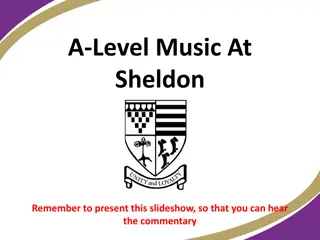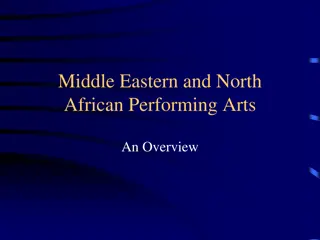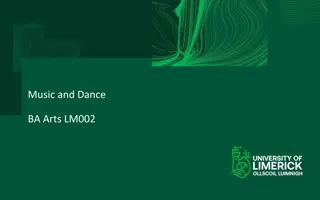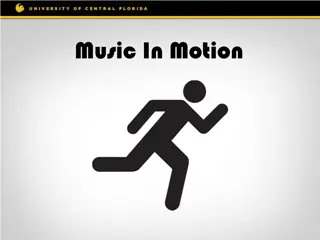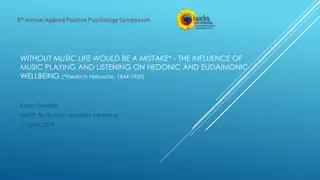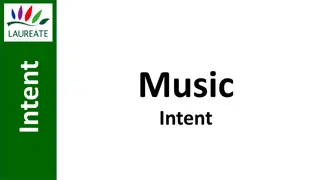Hindustani Classical Music: An Introduction to Ragas and Vocal Techniques
Indian Classical Music encompasses two main styles - Hindustani and Carnatic Classical. This article focuses on Hindustani Classical Music, exploring its rich history, prominent ragas, and vocal techniques. Learn about the elements of melody, rhythm, and harmony, as well as the significance of notes in creating beautiful compositions within the framework of different ragas.
Download Presentation

Please find below an Image/Link to download the presentation.
The content on the website is provided AS IS for your information and personal use only. It may not be sold, licensed, or shared on other websites without obtaining consent from the author.If you encounter any issues during the download, it is possible that the publisher has removed the file from their server.
You are allowed to download the files provided on this website for personal or commercial use, subject to the condition that they are used lawfully. All files are the property of their respective owners.
The content on the website is provided AS IS for your information and personal use only. It may not be sold, licensed, or shared on other websites without obtaining consent from the author.
E N D
Presentation Transcript
Presented by Shobha Shekhar At the OMEA OPUS Conference 9thNov 2019
Welcome Address and Introduction Good Afternoon & Welcome!! Personal introduction Brief explanation of my profile
9th Nov 2019 OMEA OPUS Conference
Indian Classical Music is divided into two prominent Styles The Northern Classical music Hindustani classical The Southern Classical music - Carnatic Classical Today we will talk about Hindustani Classical music and its various styles of presentation and other relative Genres. The Northern Classical Music : Hindustani Music The founder or the father of this style of music was Amir Khusrao, in the 1300 to 1500 centuries, during the Mughal Era. Ancient music deeply influenced the spiritual power of music, which led to the birth of the Indian classical music Classical music uses three basic elements for any song compositions a Melody, Rhythm and Harmony
All of these notes used in a various styles and format in a theme becomes a melody, when these notes are arranged in a specific way so as to emphasise the use of the notes and its variety. At the beginning of each lesson the notes in a particular Raaga are taught in an ascending (Aaroah) and descending ( Avroah)format. Every Raga has one or two prominent note, which is called the vadi or the samvadi swar(note) and is used in the compositions to exemplify the theme of the raag and the composition When these notes are grouped together in a singable format, this arrangement within this framework is called the Raag challan There are hundreds of ragas and they usually get their names by the notes structure used, the scale or are offshots from the many pure ragas composed where there is a slight diversion from the pure scales or notes used. Examples of Raagas in its pure format: Bhairav, Bhimpalasi, Durga, Bhoopali, Desh Examples of Mixed Raagas which are offshoots of some of the above raagas are mishra Todi, Mishra Bagashree For eg : Raag Yaman is usually called the mother of all Raagas and also taught to students as their first lesson after they practice and master all of the seven notes during their initial music lessons.
Vocal Technique In the previous slides you learnt about ascending and descending notes, Raaga and the its varieties Lets learn what notes are and how are they sung. Musical notes Indian vs Western Do, Re, Mi, Fa, Sol, La, TI . Do - Western A Demo How to voice train : Techniques
The Root Note and the use of these notes to train the vocal chords youtu.be/lVYBVir9Ukw Indian classical music has 12 notes including the root notes from the singing octave The Root note is SA and the other note progressions and patterns as under Sa, Re, Ga, Ma, Pa, Dha, Ni, Sa Sa, Re,re,Ga,ga,Ma,Ma, Pa, Dha,dha,Ni,ni, Saa Next Octave Higher Sa Re Ga Ma Pa Da Ni Sa Indian version of how to sing notes - A Demo https://youtu.be/K9TaGnr2Rfk Scales
Understanding the Hindustani classical music presentation style will be a bit more easier and simpler to explan with an insight of the notes and its use in the various raaga, Largely this style of music is presented in 4 parts, lets see what these are Raag Vistar : The notes of the raaga Vilambit Khayal ; this is usually a short 2 or 4 line ode that is sung in a 16 or 32 beat format to Bandish (short song) is the second lesson, where a short composition is used to further exemplify the raaga. Tarana The final presentation, is a type of composition in hindustani classical vocal music in which certain words and syllables (e.g. "odani", "todani", "tadeem" and "yalali"). These were inculcated from Persian and Arabic phonemesare rendered at a medium (madhya laya) or fast (drut laya).
North Indian music also is used to represent various genres like the ones below Ghazals : Ghazals are normally poetry s that are used in a song format based on a pure raag or a mixed raaga. Sufi : Sufi music was inculcated by the islamic faith who used the genre to offer prayers to the almighty and soon gained lots of popularity and hence found its way into many theatres, studios and performance platforms Bollywood : This form of music covers and includes various styles like the hiphop, rock, cabaret, classical etc Devotionals : are short compositions used to sing hymns, shlokas and other spiritual music.
Music & Meditation & Therapy Playing music, listening to music, singing or playing an instrument helps our motor skills and cognitive functions, ease stress and live a better The various section in our brain controls our brains activity, each nerve is used as a transmitter and connectors that speak to each other and perform it routine activity, thus it is considered to be an important organ that needs constant nutrition and variety of these. So other than food nutrition and other drug therapies, music tis also considered an intervention therapy that is used widely in the treatment of many ailments and disorders as it : Promote emotional health Promote our cognitive functions Help patients cope with stress, and boost psychological well-being. Relieve Stress, relax the mind, energize the body, and even help people better manage pain Meditation : A Demo https://youtu.be/a29jzOHwwq0 with OM https://youtu.be/cdB-qv4YXoY - Relaxing music and its effects
